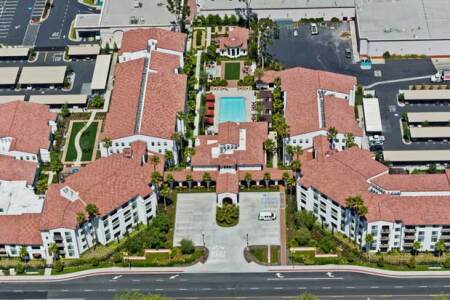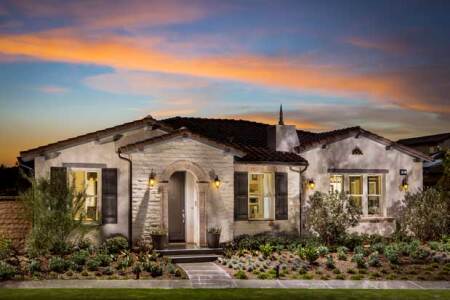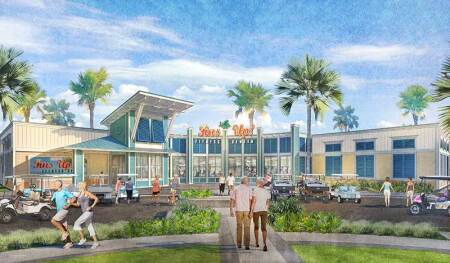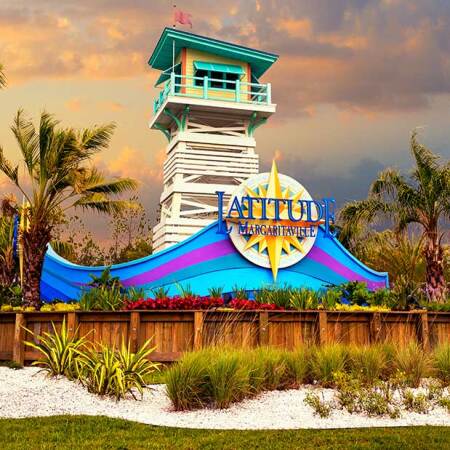Legions of America’s 77 million baby boomers are getting ready to move—at least that is the expectation—and developers are trying hard to anticipate where they will want to go. The odds are high that it will not be to the same type of planned community where they may have visited their elders.
Boomers, now roughly ages 54 to 73, are creating a surge in developments catering to their needs and whims. There is growth in luxury care communities for active adults as well as intergenerational developments where an electronic key fob may open the door to two clubhouses—an all-ages clubhouse to connect with their adult children and grandkids who live a few streets away, and an exclusive clubhouse where the boomers can play with people their own age.
Annie Gerard, a vice president with Meyers Research of Costa Mesa, California, says that between ages 55 and 70, most of these younger baby boomers remain in their established homes. “We’re still working,” she says, “and we want our garages and our yards.” People this age are mobile, vigorous, and digitally connected. “But many of the oldest baby boomers are ripe for moving,” Gerard says. “They are the prime candidates right now, and developments geared to them are squarely in position to target this huge wave of the front edge.”
“Learn your market,” advises Margaret Wylde, chief executive officer of ProMatura Group, a market research firm based in Oxford, Mississippi. “Understand what they want. Don’t copy what everybody else is doing. There are different markets even in the same city.”
There are some misperceptions about this market:
- The more amenities, the better. The problem is the cost of those amenities. Wylde says her company’s research shows that homeowners association (HOA) fees of more than $300 a month can be problematic. “The HOA fee can kill a deal before the price of a home can kill a deal,” she says. “Some places are over-amenitized, and they’ll lose share because the HOA is too high.”
- Everyone wants to downsize. “Many people assume that everyone downsizes. But there are those who don’t want to compromise. They might want to upsize: 1,500 to 2,100 square feet [139 to 195 sq m] is the sweet spot,” says Wylde.
- They are willing to pull up roots. By far, “the preference of most baby boomers is to stay put and age in place,” says Manny Gonzalez, principal of KTGY Architecture + Planning in Los Angeles.
“Adapting a home to meet changing needs—that’s probably the biggest market.” When boomers do move, it is often to places near where they have always lived. “For the most part, people will come from a 10- to 15-mile [16 to 24 km] radius from their homes,” says Gonzalez. “They don’t want to leave their churches or their doctors. They are moving out of the house and cashing out and want to have less home maintenance.”
The average age for move-in to active adult communities—whether on the other side of town or the other side of the country—is 70 to 72, says Gerard. The key word for this market appears to be active, and an increasing variety of lifestyle options are being offered to residents.
For example, KTGY has designed age 55-plus enclaves across the country. In Costa Mesa, the firm designed the Azulón at Mesa Verde 55-plus apartment complex around a recreation center and three courtyards with a direct connection to the shopping center next door. A recent study by Perkins Eastman, an international design and consulting firm, predicts that future hybrid developments will take the form of a “vertical Main Street,” in which mid-rise senior living towers rise out of existing shopping malls offering multiple activities.
On the outskirts of Las Vegas, KTGY has designed Trilogy in Summerlin, an age 55-plus enclave. (Summerlin also is home to a development by retirement-living pioneer Sun City.) Trilogy offers 354 residences, including condominium units and vertical duplex homes with elevators and nighttime views of the illuminated Las Vegas Strip. Amenities within and around the resort club are a second-story media and game lounge featuring billiards, shuffle board, TVs, and an outside covered patio with fireplace, outdoor resort-style pool with cabanas, bocce courts, pickleball courts, culinary studio, fitness room, and multi-use room.
Urban Luxury
For many mature home seekers, urban living is a draw. In October 2018, Atria Senior Living announced a partnership with luxury real estate developer the Related Companies to invest $3 billion to build senior living properties in the biggest U.S. cities, including New York City, Boston, Los Angeles, Miami, and Washington, D.C. In May, the Related/Atria joint venture announced a partnership with Welltower (a Toledo, Ohio, real estate investment trust) to convert a TV station headquarters building in San Francisco to provide senior housing by the end of 2021. The site is one block from the new California Pacific Medical Center’s Van Ness campus. The still-to-be-branded residences will range from about 150 to 250 units, with up to 25 percent of the units to be for memory care. Initial plans call for partnerships between the facilities and local hospitals. Louisville, Kentucky–based Atria operates more than 200 senior residences in 27 states and Canada.
“We have long focused on designing and building luxury environments in our country’s most vibrant cities that cater to every aspect of our resident’s lifestyle,” said Jeff T. Blau, chief executive officer of Related, in an October 2018 announcement. “This new venture is really a response to a growing need we are seeing from our core urban customers who are looking for a luxurious home as they age, or for their aging loved ones, that is close by and where best-in-class care will be provided.”
Rental Options
Gerard says significant growth can be seen in “discretionary renters or renters by choice” who may want to explore new places to live as their adult children move to locations away from where they were raised. Those active adults want rentals because “they like the convenience of not having to do the home maintenance work. They like being able to lock and leave. They like those amenities and lifestyles, and you’re not locking yourself into one location for years,” says Gerard. “You can go live in Texas for two years when the kids are transferred. Rather than being forced to sell or buy, you can choose your own timing with a rental.”
Luxury urban condominium projects also attract active adults, says Gerard. Many renters are women in their 70s, she says. They desire walkability and the proximity to services that most apartment dwellers focus on, and they are especially sensitive to safety and security. That makes them less likely to move into pioneering developments, such as lofts in downtown Los Angeles or resurgent Detroit.
Residential rental property giant Greystar has targeted active adults with its Overture brand and buildings with community concierges and activity directors in 13 states, including Virginia, Illinois, and Washington state.
Niche Communities
Longstanding communities have been planned around groups of different beliefs and interests, from retired postal carriers who inhabit 500 apartments near Orlando in central Florida to communities of astronomy aficionados in New Mexico, Texas, and Florida.
Fountaingrove Lodge in Santa Rosa, California, with striking views of Sonoma wine country, is the first of its kind targeting affluent LGBT retirees. It offers luxury senior housing with 70 apartments ranging from 833 to 2,001 square feet (77 to 186 sq m) and a handful of detached homes. Now home to about 100 residents, Fountaingrove Lodge provides continuing care services on site, and a spa, a movie theater, a swimming pool, and—this being California wine country—a community wine cellar.
Northern California also will be home to a senior living community inspired by and affiliated with the San Francisco Zen Center. It will be integrated into a mixed-use development. On the site of a former lumber mill in Sonoma County, Enso Village will contain 290 residential units for midmarket and workforce renters and a 130-unit hotel. But for older adults, another parcel will include 220 independent living units, 30 assisted-living units, plus memory care housing. Zen Center instructors, who specialize in nurturing the value of meditation and reflection, will get first choice on units in the complex as they age.
“They made a promise to their monks, their most revered teachers, that when they reach a certain age, they get free housing and free board for life,” says Gerard, who says she did research for the developers. The developers are aiming to take reservation deposits in 2020 for an anticipated 2023 opening.
And, inspired by the Jimmy Buffett song “Margaritaville,” the Latitude Margaritaville community in Daytona Beach, Florida, is promoting an amenity-rich sun-filled paradise for people 55 and older. And its appeal is intended to extend far beyond Buffett’s parrothead fans. In March 2018, the Daytona Beach location welcomed residents into the first dwellings of a planned 3,000-home community. That year, Latitude Margaritaville sold 412 homes and was on pace to match those sales figures in 2019, William Bullock, president of homebuilder Minto’s Latitude Margaritaville division, told the Daytona Beach News Journal in a June 23 article.
To make sure paradise is affordable, Bullock said a new home design called the Conch Cottage will have a starting price in the low $200,000s, offering 1,200 square feet (112 sq m) of space. That compares with a 1,500-square-foot (139 sq m) villa unit at $253,990 up to a single-family residence with 2,310 square feet (215 sq m) of space at $354,990.
Another Latitude Margaritaville development has opened in Hilton Head, South Carolina, with plans calling for a total of 3,000 homes starting in the mid-$200,000s. Farther west in the Florida Panhandle, Minto Communities and Margaritaville Holdings have announced a third location, Latitude Margarita-ville Watersound, an active adult community near Panama City Beach. Groundbreaking is scheduled to take place by year’s end.
The companies are partnering with the St. Joe Company, a real estate development firm with vast landholdings in the Panhandle. The company is new to developing for the active-adult residential market. “It’s a demographic where there’s a need, what with baby boomers being such a large part of the population,” St. Joe chief executive officer Jorge Gonzalez told the News Herald of Panama City for a June 2019 article.
Manny Gonzalez of KTGY praises Latitude Margaritaville’s branding and design. “They are doing a wonderful job. The amenities are spectacular. They give a ‘frozen concoction’ device with every residence they sell,” he says, referencing the “Margaritaville” song’s lauding of “that frozen concoction that helps me hang on.” “My only concern is, will the owners now be able to sell the house to the next round of buyers who are 40 now and didn’t grow up with the song? The feel of the Caribbean and with the quality of what they are doing, it’s probably enough to have people buy without the Jimmy Buffett sales pitch.”
Intergenerational Communities
In Orange County, California, Manny Gonzalez designed homes in the first Gavilán neighborhood for age 55-plus adults in the massive Rancho Mission Viejo (RMV) development. When completed, 11 Gavilán enclaves will be nestled across 6,000 acres (2,400 ha) of Rancho Mission Viejo offering all-ages housing. Gavilán neighborhoods have their own private amenities and clubhouses, while their residents also have access to any amenities offered at RMV that are not restricted to people 55 and older.
The initial Gavilán community was about 400 age-qualified homes in a gated community. “While the active adult community has their own clubhouse, they also can use the all-ages clubhouse, something you won’t find in the traditional 55-plus model,” said Gonzalez. “Here you have the benefits of an active adult community while still being a part of a vibrant, multi-generation master plan.”
RMV is a private, family-held 22,000-acre (8,900 ha) property that has been operating as a cattle ranch since 1882. From 2013, when the first residents moved in, through the next two decades, RMV expects to develop 6,000 acres (2,400 ha) for 14,000 homes, including the 11 Gavilán neighborhoods designed for adult ages 55 and older and offering a mix of houses and apartments.
“Research showed they wanted exclusivity in fitness, pools, and some social spaces,” says Amaya Genaro, RMV’s director of community services, “but they’re willing to share social space as well.”“We knew we had to be focused on lifestyle,” says Genaro. “Most people don’t move into a 55-plus community when they’re 55. Our average age is mid-60s.”
Cognizant that adults of all ages want access to casual dining and beverages, Rancho Mission Viejo obtained its own liquor licenses. But rather than operating permanent restaurants or bars, the community operates what might be dubbed pop-up bars and grills more related to programming. There are Taco Tuesdays, for example, or Wine Down Wednesdays around the bocce court. “We don’t want anyone to drink alone. The bars are there when there’s an actual activity around it,” says Genaro. The pop-up approach is also more economical.
Rancho Mission Viejo also uses different builders, including Del Webb, Toll Brothers, William Lyon, and Four Seasons. “We’ve allowed a multitude of builders who want to serve the 55-plus community. We take on the lifestyle, and all they have to do is build great homes,” says Paul Johnson, RMV executive vice president of community management. “I think that’s allowed our boomers to have a bigger choice in home types.”
RMV has sought to keep HOA fees between $300 and $350 a month. And Rancho Mission Viejo offers its own digital app so residents can view a calendar, submit maintenance requests, and check out the Ranch Ride trolley for jaunts to events in San Juan Capistrano, San Clemente, or Laguna Beach.
“Communication is important to this group and to stay ahead of what’s happening,” says Johnson. “We did a lot of work to look at the boomers, who were saying ‘I just want to live like everybody else’ and ‘I don’t want a big label on the front door that says 55-plus living here.’”
A Growing Market
By 2035, the number of Americans age 65 or older is projected to increase from 48 million to 79 million. That means one in five Americans will be age 65 or older (up from one in seven today), and about 33 percent of American households will be headed by a senior, according to the Joint Center for Housing Studies at Harvard University.
Over the next 20 years, an estimated 825,000 households headed by older adults will move into a new home. Some 1.6 million similar households will move into rentals yearly, according to the November 2018 Harvard study “Projections and Implications for Housing a Growing Population: Older Households 2015–2035.”
“It’s going to be a great market for the next 10 to 15 years and even beyond that,” says Wylde of ProMatura Group.
“All of the slices of the pie are going to get bigger,” says Gerard. “I think people in the senior housing industry get that this is not a monolithic market. Even within the smaller slices, there are a lot of differences.”











